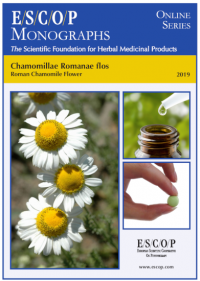
ESCOP monographs The Scientific Foundation for Herbal Medicinal Products. Online series. Chamomillae romanae flos (Roman chamomile flower). Exeter: ESCOP; 2019.
Chamomillae romanae flos Online viewing (for only ¤30 per year, free for members of societies belonging to ESCOP Download monograph SUMMARY The herbal monograph selects and summarizes scientific studies and
textbooks regarding efficacy, dosage and safety to support the
therapeutic uses of roman chamomile flower. This herbal drug by definition consists of the dried flower-heads of the cultivated double flowered variety of Chamaemelum nobile (L.) All. (syn. Anthemis nobilis L.). Studies with its main characteristic constituents the essential oil
and flavonoids such as apigenin-glycosides are included. The therapeutic
indications are symptomatic treatment of mild dyspeptic complaints,
such as bloating, nausea, flatulence and lack of appetite, minor
inflammations of the oral mucosa and skin in wounds and abrasions; as an
itch-relieving agent and for eye irritation or discomfort. Administration of roman chamomile flower addresses posology; its
duration of use; contra-indications; special warnings; special
precautions for use; interactions with other medicinal products; other
forms of interaction; in pregnancy and lactation; its effects on ability
to drive; undesirable effects; overdose. In vitro experiments with roman chamomile flower or its
essential oil demonstrated antimicrobial, antiplatelet and
anti-inflammatory effects. In vivo experiments with roman
chamomile flower, its oil and extracts in animals showed
anti-inflammatory, diuretic and hypoglycemic properties. Preclinical safety data were assessed in toxicity studies. Safety
data were assessed in human studies. Sensitization to roman chamomile
flower or its oil has been reported. The selection of literature cited in the monograph is aimed at
bringing together relevant information about the possible physiological
roles of roman chamomile flower and its major constituents. KEYWORDS
Roman chamomile flower
Chamaemelum nobile (L.) All. (Syn: Anthemis nobilis L.)
Published 2019
Format: PDF



